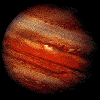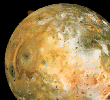
 Jupiter
Jupiter

Planet Profile
Mass (kg)............................................1.90 x 10^27
Diameter (km)........................................142,800
Mean density (kg/m^3) ...............................1314
Escape velocity (m/sec)..............................59500
Average distance from Sun (AU).......................5.203
Rotation period (length of day in Earth hours).........9.8
Revolution period (length of year) (in Earth years)..11.86
Obliquity (tilt of axis) (degrees)...................3.08
Orbit inclination (degrees)..........................1.3
Orbit eccentricity...................................0.048
Mean surface temperature (K).........................120 (cloud tops)
Visual geometric albedo..............................0.44
Atmospheric components...............................90% hydrogen,
10% helium,
.07% methane
Rings................................................Faint ring.
Infrared spectra imply dark rock fragments.

 Full Disk
Full Disk
Jupiter is a "gas giant"; all gas giants are similar to Jupiter in
composition. Jupiter's diameter is 11 times Earth's diameter and 20%
larger than Saturn's, making it the largest planet in the solar
system. Gas giants are also very much larger than terrestrial
planets. This color-enhanced image of Jupiter was taken by Voyager 1.
 Jovian System
Jovian System
Voyager 1 took this photo of Jupiter and two of its satellites, Io on
the left and Europa on the right. Io is about 350,000 km (217,000 mi)
above Jupiter's Great Red Spot; Europa is about 600,000 km (372,000 mi)
above Jupiter's clouds. Although both satellites have about the same
brightness, Io's color is different from Europa's. Io's equatorial
region shows two shades of red, possibly indicating different surface
materials.
 The Great Red Spot
The Great Red Spot
The colorful, wavy cloud pattern to the left of the Red Spot is a
region of extraordinarily complex wave motion. This dramatic view of
the Great Red Spot and its surroundings was taken February 25, 1979,
when Voyager 1 was 9.2 million km (5.7 million mi) from Jupiter. An
atmospheric system larger than Earth and more than 300 years old, the
Great Red Spot remains a mystery. Swirling, storm-like features
possibly associated with wind shear can be seen both to the left and
above the Red Spot.
 White Cloud
White Cloud
This mosaic of the Great Red Spot was taken by the Voyager 2
spacecraft. It shows that the region changed significantly since the
Voyager 1 encounter four months earlier. Around the northern boundary a
white cloud is seen, which extends east of the region. The presence of
this cloud prevents small cloud vertices from circling the spot in the
manner seen in the Voyager 1 encounter.
 Red Spot Turbulence
Red Spot Turbulence
The turbulence surrounding the Great Red Spot is shown here in enhanced
color, which tends to emphasize red and blue at the expense of
green. Near the bottom you can see one of three oval cloud systems that
formed nearly 40 years ago. The distance from top to bottom of this
picture is 24,000 km (15,000 mi).
 East of the Red Spot
East of the Red Spot
The region just east of the Red Spot is seen here in greatly
exaggerated color. The colors do not represent the true hues seen in
the Jovian atmosphere but have been produced by special computer
processing to enhance subtle variations in both color and shading. A
close-up of one of the boundaries between the latitudinal cloud bands
shows interaction between the bands.
 Large Brown Oval
Large Brown Oval
This large brown oval could be an opening in the upper cloud deck where
warmer cloud levels may exist. Features of this sort are not rare on
Jupiter and have an average lifetime of one to two years. Above the
feature is the pale orange North Temperate Belt, bounded on the south
by the high-speed North Temperate Current with winds of 120 m/s (260
mi/hr). The range to Jupiter, on March 2, 1979 when this photograph was
taken, was 4.0 million km (2.5 million mi).
 Ring System
Ring System
Data from the Pioneer 10 and 11 spacecraft suggested that a ring system
around the giant planet Jupiter existed; this was confirmed by the
Voyager flybys. This image was taken by Voyager 2 looking back at the
rings from inside Jupiter's shadow. The ring is very bright because it
is composed of fine dust, which scatters light efficiently in this
viewing geometry. The picture shows the main ring 7000 km (4350 mi)
wide, with a broad, thick "halo" inside it.
 Global Mosaic
Global Mosaic
Io's surface materials are rich in sulfur compounds. Its volcanism is
driven by tidal stresses induced by Jupiter and the next satellite out,
Europa. Black lava lakes dot Io's surface, some of them as hot as 200
øC (392 øF). Io measures 3630 km (2178 mi) in diameter.
 Io's South Pole
Io's South Pole
Numerous volcanic features dot the south polar region of Io, including
lava flows around calderas. Scientists think that the bright patches
seen here may be due to sulfur dioxide ice and gas jetted from
fractures in the surface.
 Explosion on Io
Explosion on Io
A volcanic explosion can be seen silhouetted against dark space over
Io's brilliant limb. Solid material was blasted to an altitude of about
160 km (100 mi), requiring an ejection velocity from the volcanic vent
of about 1920 km (1200 mi) per hour. Io appears to be far more
volcanically active than Earth.
 Erupting Volcano
Erupting Volcano
The blue and white protrusion visible on the limb is an eruption of
Volcano Loki. This picture of Io was taken by the Voyager 2 spacecraft
in July 1979, during its closest approach to Jupiter's satellite.
 Volcanic Plume
Volcanic Plume
These images were specially processed to show detail both on the
surface of Io and in the faint plume. This volcano is named
Prometheus. The eruption is thought to be driven by sulfur dioxide
gas that is heated by molten sulfur and driven out of the vent at a
velocity of about 1/2 km (0.3 mi) per second. The plume reaches an
altitude of about 50 km (30 mi), spreading out over a diameter of
about 300 km (190 mi).
 Volcanic Eruption
Volcanic Eruption
The eruption seen here is coming from the volcano named Prometheus. The
eruption is roughly 300 km (190 mi) in diameter and 50 km (30 mi)
high. It appears like a giant black spider standing in a white ring on
the surface of Io, located at the center of the curve of the limb.
 Venting Gases
Venting Gases
On the floor of the northern-most caldera in this image lies a bright
blue patch. Scientists believe that patch may be gas clouds spewing
from volcanic vents. The clouds may condense to form extremely fine
particles that appear blue. Because Voyager 1's infrared spectrometer
discovered sulfur dioxide on Io, it is possible that sulfur dioxide is
the main ingredient of the clouds. Such clouds would rapidly freeze and
snow back to the surface. It is also possible that dark areas on the
caldera floors are pools of molten sulfur, a very dark form of sulfur.
 South Pole
South Pole
Scientists believe that the surface of Europa is made up of ice mixed
with rocky material. Complex ridges tracing cuspate forms testify to
tectonic processes ongoing on this world. This image shows the area
along the terminator extending into the south polar region.
 Europa in Color
Europa in Color
Europa, close in size to our Moon, is thought to have an ice surface
100 km (62 mi) thick, which overlies a silicate surface. The complex
array of streaks indicates that the crust has been fractured. The lack
of mountains or craters on its bright limb is consistent with an ice
surface. In contrast to its icy neighbors, Ganymede and Callisto,
Europa has few impact craters. One possible candidate is the small
feature near the center of this image with radiating rays and a bright
circular interior. The relative absence of features and low topography
suggests the crust is young.
 Limb of Ganymede
Limb of Ganymede
The interior of Ganymede is thought to consist of a rocky core about
the size of our Moon and to be surrounded by a thick covering of ice
roughly equal in mass. Because the surface of Ganymede is made of ice,
mountainous terrain would eventually collapse. Complex intersecting
avenues of dark and bright terrains record multiple episodes in which
the crust was fractured and reformed by icy volcanic fluids. About the
size of Mercury, Ganymede is 5280 km (3168 mi) in diameter.
 Tectonic Patterns
Tectonic Patterns
On Ganymede, complex tectonic patterns have formed on the icy
crust. Two explanations for their creation have been offered. First,
these patterns are produced by tectonic forces that squeeze and wrinkle
the surface. These patterns resemble dikes on Earth so that a second
possibility is that these patterns might have formed when liquid water
rose through the closely spaced faults near the surface and froze. The
area shown is about 100 km (62 mi) on a side.
 Halo Crater
Halo Crater
A bright halo impact crater with fresh ejecta is visible here. Behind
the crater is bright grooved terrain, which may be the result of
shearing of surface materials along fault planes. The dark background
material is the ancient heavily cratered terrain; the oldest material
on Ganymede. Features as small as 6 km (4 mi) across are visible in
this image.
 Ancient Terrain
Ancient Terrain
This color reconstruction of part of the northern hemisphere of
Ganymede was made from pictures taken at a range of 313,000 km (194,000
mi). It shows a dark, densely cratered area bound on the south by
lighter, less cratered grooved terrain. Dark areas are believed to be
the oldest surface on Ganymede. Numerous craters, many with central
peaks, are visible. The large bright circular features have little
relief and are probably the remnants of old, large craters. The closely
spaced, arcuate features are similar to other features on Ganymede that
surround large impact basins.
 Impact Scar
Impact Scar
Callisto, composed of rock and ice, is covered with numerous impact
craters. The largest of these is Valhalla Basin, a 2748-km (1650-mi)
multi-ring impact basin near the top of the image. Craters on Callisto
appear as bright and dark spots whose morphology changes. Newer craters
appear as sharply defined bright and dark spots. Over time older
craters appear as more diffuse splotches.
 Impact Craters
Impact Craters
This Voyager image is of Callisto, Jupiter's fourth large satellite. It
is one of the Galilean satellites, so named because Galileo saw them
when he first turned his telescope toward Jupiter. Callisto shows a
surface saturated with impact scars attesting to the great age of this
icy world.

 Welcome to the Planets Home Page
Welcome to the Planets Home Page


 Jupiter
Jupiter

 Full Disk
Full Disk  Jovian System
Jovian System  The Great Red Spot
The Great Red Spot  White Cloud
White Cloud  Red Spot Turbulence
Red Spot Turbulence  East of the Red Spot
East of the Red Spot  Large Brown Oval
Large Brown Oval  Ring System
Ring System  Global Mosaic
Global Mosaic  Io's South Pole
Io's South Pole  Explosion on Io
Explosion on Io  Erupting Volcano
Erupting Volcano  Volcanic Plume
Volcanic Plume  Volcanic Eruption
Volcanic Eruption  Venting Gases
Venting Gases  South Pole
South Pole  Europa in Color
Europa in Color  Limb of Ganymede
Limb of Ganymede  Tectonic Patterns
Tectonic Patterns  Halo Crater
Halo Crater  Ancient Terrain
Ancient Terrain  Impact Scar
Impact Scar  Impact Craters
Impact Craters 